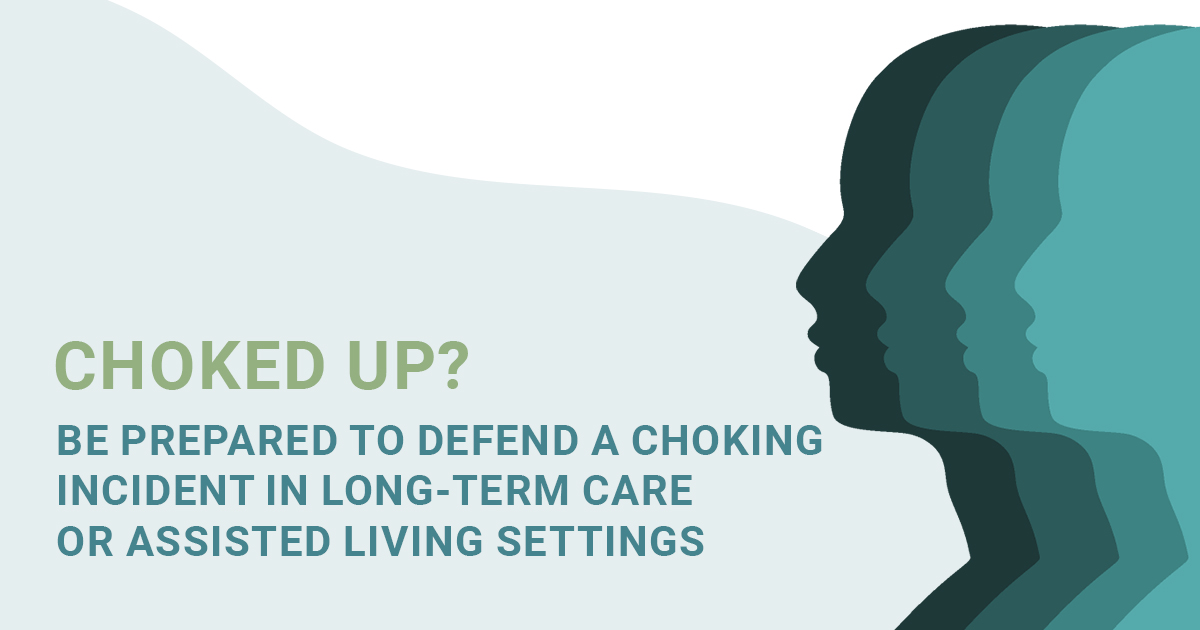Be Prepared to Defend a Choking Incident in Long-Term Care or Assisted Living Settings

Choking is the fourth leading cause of unintentional injury death in the United States. In 2021, there were approximately 5,325 choking deaths in the United States. Statistics show that the overall instances of choking are gradually increasing and are most prevalent among the elderly, with food most often responsible for such incidents. This increased risk in the elderly is partly due to risk factors, including age-related changes, the use of dentures, living alone, medications, and difficulty swallowing. Dysphagia, or difficulty swallowing, is a significant risk factor for choking at any age. However, chronic diseases which often affect the elderly population, including cerebrovascular disease, Parkinson’s disease, Alzheimer’s disease, or dementia, increase the risk of developing dysphagia and therefore increase the risk of choking. Since the cough reflex has motor, sensory, and cognitive components, this reflex decreases with age, increasing the risk of choking and aspiration in the elderly. Additionally, the need for medication with sedative qualities, such as antipsychotics, opioid analgesics, hypnotics, and anti-anxiety medications, impact the central nervous system and can also impair the integrity of the swallow and cough reflexes, increasing the risk of choking.
Can choking be prevented?
Although not all choking events can be prevented, the first line of defense in preventing any potential issue/incident is risk assessment. Residents of long-term care and assisted living facilities should be screened on admission for any difficulties with chewing or swallowing. This is often done as a part of the admission assessment by the nursing staff and during nutritional assessments, allowing for early recognition and intervention. The following features may help to identify elders at risk of eating or swallowing problems;
1. Increased age (more than 65 years of age)
2. Poor dental status
3. Postural instability during meals
4. Poor mobility
5. Fatigue during meals
6. Sedative, opioid, or antipsychotic medications
7. Chronic vs. acute lung infections
8. Diagnoses associated with possible dysphagia
A multidisciplinary approach in the assessment of each resident is of utmost importance. Should issues with swallowing be identified, speech therapy should be involved for additional assessments and treatment. More specific swallowing assessments may be utilized, including fiberoptic endoscopy of swallowing (FEES) or videofluoroscopy (VFS). Based on assessment findings, multiple methods can be used to prevent choking in those deemed at risk. Interventions can include texture modification of foods, ensuring proper positioning during intake, implementation of swallowing maneuvers, provision of thickened liquids, alternating intake of foods and fluids during meals, providing assistance with intake, and supervision. The importance of supervision of the elderly during meal times cannot be overstated. Additionally, residents who have dementia and/or wander and may pick up food from other sources while unattended are at risk for choking in a long-term care or assisted living facility setting and would require additional supervision. Staff education and training concerning providing food and snacks as ordered by the physician and the ability to perform first aid should a choking episode occur is also paramount.
The legal nurse consultants of Med Law Advisory Partners are well-versed in the standards of care and regulations governing long-term care and assisted living facilities throughout the nation. We at Med Law Advisory Partners can assist with the defense of these cases and help you to reduce facility liability.